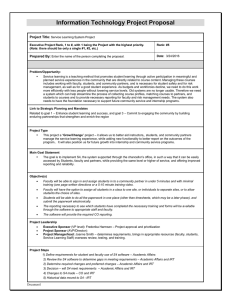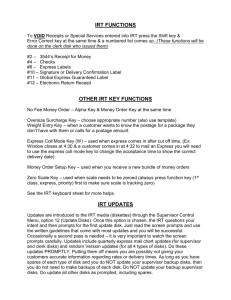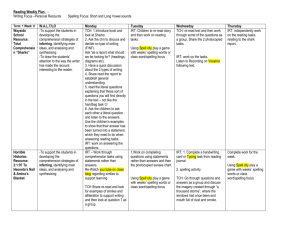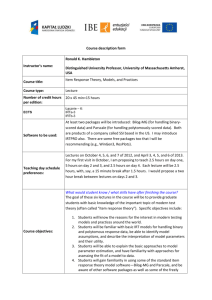National Missile Defense Independent Review Team (NMD IRT) Executive Summary Charter
advertisement
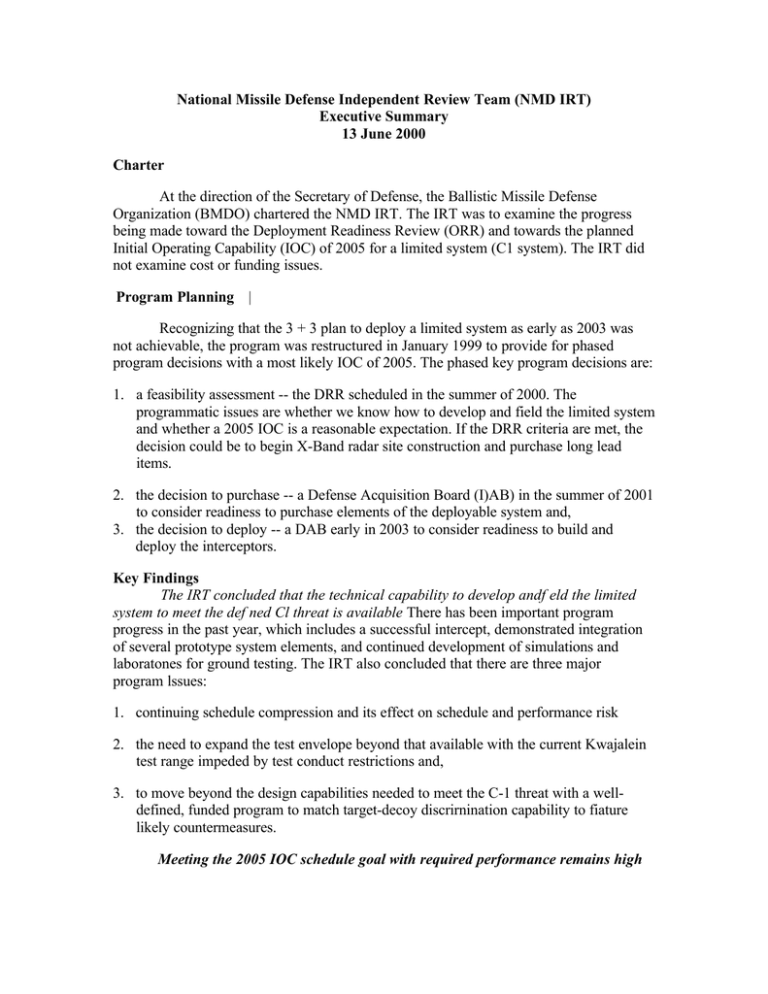
National Missile Defense Independent Review Team (NMD IRT) Executive Summary 13 June 2000 Charter At the direction of the Secretary of Defense, the Ballistic Missile Defense Organization (BMDO) chartered the NMD IRT. The IRT was to examine the progress being made toward the Deployment Readiness Review (ORR) and towards the planned Initial Operating Capability (IOC) of 2005 for a limited system (C1 system). The IRT did not examine cost or funding issues. Program Planning | Recognizing that the 3 + 3 plan to deploy a limited system as early as 2003 was not achievable, the program was restructured in January 1999 to provide for phased program decisions with a most likely IOC of 2005. The phased key program decisions are: 1. a feasibility assessment -- the DRR scheduled in the summer of 2000. The programmatic issues are whether we know how to develop and field the limited system and whether a 2005 IOC is a reasonable expectation. If the DRR criteria are met, the decision could be to begin X-Band radar site construction and purchase long lead items. 2. the decision to purchase -- a Defense Acquisition Board (I)AB) in the summer of 2001 to consider readiness to purchase elements of the deployable system and, 3. the decision to deploy -- a DAB early in 2003 to consider readiness to build and deploy the interceptors. Key Findings The IRT concluded that the technical capability to develop andf eld the limited system to meet the def ned Cl threat is available There has been important program progress in the past year, which includes a successful intercept, demonstrated integration of several prototype system elements, and continued development of simulations and laboratones for ground testing. The IRT also concluded that there are three major program lssues: 1. continuing schedule compression and its effect on schedule and performance risk 2. the need to expand the test envelope beyond that available with the current Kwajalein test range impeded by test conduct restrictions and, 3. to move beyond the design capabilities needed to meet the C-1 threat with a welldefined, funded program to match target-decoy discrirnination capability to fiature likely countermeasures. Meeting the 2005 IOC schedule goal with required performance remains high risk. However, the IRT sees no technical reason to change the schedule at present. So long as meeting performance milestones is the criteria for moving to the next event or next decision, the schedule will be self-adjusting as needed. Each of the program decision 1 milestones described earlier must be preceded by key performance milestones. Since the restructure in January 1999, various key performance milestones have slipped four to eight months and the schedule has been adjusted accordingly. Regarding the first decision milestone, the DRR, the criteria include two successful intercepts, one of which must be an Integrated System Test (IST), that is, a test that includes integrating the multiple elements of the system - radar, ground based interceptor, command and control, and communications. Integrated Flight Test - 4 (IFT - ) was to be the first possible IST. It was four months behind schedule and did not achieve an intercept due to failure of components of the IR sensor system on the Exo-Atmospheric Kill Vehicle (EKV). It did demonstrate integration of the system to a degree not previously achieved. The need for a thorough assessment of the results and subsequent action to prepare for IFT-5 has necessitated an adjustment to the DRR schedule and further adjustments are likely since IFT-5 is now backed up against the rescheduled DRR. Regarding the second milestone, the 2001 DAB, a performance pre-requisite is an integrated production configuration booster and EKV flight (IFT-7) to assess the compatibility of all the components of the interceptor. The preceding tests use a legacy booster. The development of the new booster is eight months behind the restructured schedule. This pushes IFT-7 up against the 2001 DAB and will probably require an adjustment intheDAB schedule. A pre-requisite to the third milestone, the DAB in 2003 for the decision to deploy the interceptors, is an intercept using the production configuration Ground-Based Interceptor - the production EKV mated to the production booster. The schedule for this test (IFT-13) is now backed up against the DAB schedule. The current plan is to try to move this test forward to IFT-12. Due to a variety offlight test restrictions on over~ight, impact area, and debris in space, current plans provide f light tests in only a limited part of the required operating envelope. This impacts confidence in the validity of system simulations used to assess performance throughout the rest of the operating envelope. The IRT has suggested approaches that could provide additional test points. These approaches require both policy decisions and resources. Even a limited expansion of the test envelope makes an important contribution to confidence in the validity of the system simulations. The IRT believes that design discrimination capabilities are adequate to meet the defined C-l threat. However, more advanced decoy suites are likely to escalate the discrimination challenge. The mid-course phase BMD concept used in the current NMD program has in~portant architectural advantages. At the same time, that concept requires critical attention to potential countermeasure challenges. There is extensive potential in the system design to grow discrimination capabilities. The program to more fully understand needs and to exploit and expand this growth potential to meet future threats needs to be well defined, clearly assigned, and fi~nded now. A panel of the IRT is continuing work in this area. 2 Continuing Key Risk Areas Technical - Completing the design, testing, and production of the EKV to include manufacturing and quality control to meet the high reliability requirements remains high risk. Requirements - There is an urgent need to complete the definition of all environmental conditions and accompanying design and test requirements. Schedule - As already discussed, stressing challenges remain to demonstrate the required performance and reliability of the Ground-Based Interceptor in time for a 2005 IOC. Integration - There are still high-risk software and hardware challenges in moving from legacy or prototype program elements to production configurations and converging them into an integrated system. Special area -- Providing confidence in perforrnance to the specified level across the operating envelope depends to an unprecedented degree on confidence in system simulations. Confidence will be heavily dependent on the degree to which the simulations are anchored in physical testing. Threat evolution - A parallel, continuing development program is needed for the deployed system to deal with future countermeasures. Summary Of Conclusions The deployment readiness review this summer is a feasibility assessment of the NMD program. The final deployment decision is planned for the summer of 2003. Technical capability to develop and field the limited system to meet the defined threat in 2005 is available | Meeting the 2005 IOC schedule goal with the required technical performance remains high risk However, the IRT sees no reason to change the schedule at present. The test envelope needs to be expanded beyond that now permitted with current restrictions | While we believe the current design requirements will meet the C-1 threat, the NMD program requires critical attention to potential countermeasures challenges to execute the planned evolut~cnary approach to the threat. The IRT will continue to review the program with particular emphasis on countermeasure challenges. 3
